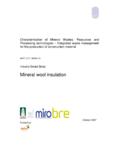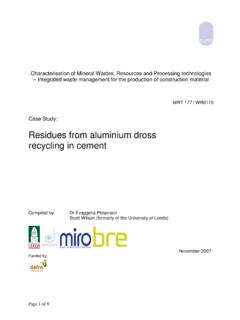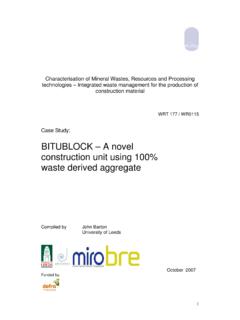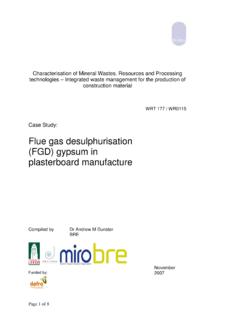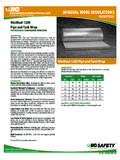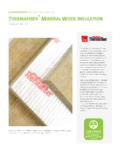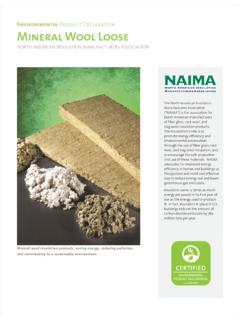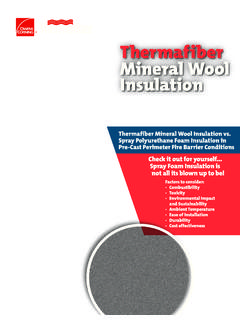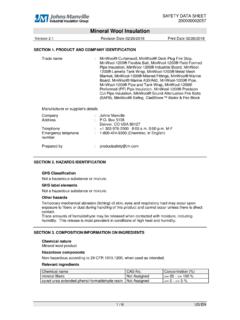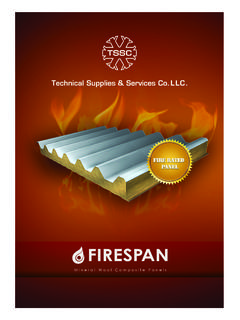Transcription of Ceiling tiles waste mineral wool - SMARTWaste
1 Page 1 of 7 Characterisation of mineral Wastes, Resources and Processing technologies Integrated waste management for the production of construction material WRT 177 / WR0115 Case Study: waste mineral fibre in Ceiling tile manufacture Compiled by Dr Andrew M Dunster BRE Funded by: November 2007 Page 2 of 7 Introduction waste mineral fibre is generally off-spec mineral fibre products generated by the manufacturers of mineral or glass wool . Providing the waste material is a clean, consistent mineral fibre, it is generally suitable for use in the manufacture of Ceiling tiles or in other applications. The total quantity of waste mineral wool produced in the UK is believed to be about 10,000 Tonnes (1) Current recycling and disposal routes for waste mineral fibre are:- possible re-use through re-melting into mineral wool production (involving capital intensive cleaning to remove coatings etc); use as a raw material in the manufacture of mineral fibre Ceiling tiles ; small volume speciality sales or landfill.
2 waste mineral fibre is extremely difficult to recycle back into mineral wool production due to the presence of the organic coatings which would create emissions to air if heated (1). : Figure 1: waste mineral fibre bales In functional terms, waste mineral fibre is a bulky material. It is chemically inert and stable and comprises fibres 3 - 10 microns in diameter and various fibre lengths up to There is some organic content due to residual coatings on the fibres. It is generally classed (European waste Catalogue) as man-made vitreous (silicate) loose mineral fibres . Its appearance is a solid that may be grey/green/yellow/pink in colour dependent on minerals used. The composition is also variable but including SiO2, Al2O3, CaO and MgO. Potential construction applications for waste mineral fibre waste mineral wool is suitable for incorporation into thermal, or acoustical insulation products.
3 Examples include mineral wool insulation, mineral wool suspended Ceiling tiles , fire protection products, panels (2,3). Page 3 of 7 Ceiling tile manufacture The waste mineral wool /fibre is used as a direct substitute for other mineral fibres, and is dispersed in a solution of cold water, before being blended with the other fillers and binder ingredients. The mass is then formed into a continuous mat before being cut into sheets for drying. The dried sheets are then fabricated, finish coated and cut to final size. mineral fibre Ceiling tiles contain up to 75% recycled content (6, 7). The content of recycled mineral fibre is not clear. However, levels of substitution of new fibre by waste fibre could be as high as 100% by weight, (the tile may be 25 to 75% mineral fibre). Ceiling tiles have a range of performance characteristics which can include resistance and reaction to fire properties, acoustical absorption and attenuation, light reflectance, basic physical strength and durability.
4 The content and type of mineral wool used in these products will impact on these characteristics. The Ceiling tile manufacturing industry has a history and willingness to utilise by-products and has often replaced virgin raw materials with (usually) lower cost alternatives. The use of blastfurnace slag (from iron smelting) as the main mineral input into the melting and spinning process for mineral wool , as an alternative to quarried rock is one example. Starch recovered from the potato snack industry has been used as an alternative binder to virgin material in the manufacture of Ceiling tiles . Ceiling tiles are used extensively in non-residential buildings in the UK and Europe as panels in suspended Ceiling systems; (offices, shops, schools, hospitals, hotels etc.).They are supplied in a number of decorative finishes but are pre-dominantly white in most applications.
5 The UK market for suspended mineral fibre ceilings is estimated to be around 15 million sq. metres per annum (4). In 2006 it was estimated that the total market size by volume for suspended Ceiling tiles in the UK was approximately 21-22 million square metres (5). Page 4 of 7 Barriers and Benefits There are a range of benefits, obstacles and analysis required for determining the potential for waste mineral fibre to be utilised in the manufacture of Ceiling tiles , this information is shown below: 1) Contribution to the end product: The waste mineral wool acts as a substitute for primary mineral wool . 2) Potential benefits: o Material related ii. Local suppliers save both financial and environmental costs. o Legislation-related: o Environmental-organisational-social: ii. The use of waste fibre reduces the environmental impact caused by the production of virgin alternatives.
6 Iii. Avoidance of material going to landfill o Economic: iv. Gate fee (benefit to manufacturer) v. The need to buy primary material is reduced (benefit to manufacturer) 3) Potential barriers: o Material related: ii. mineral fibre waste needs to be clean and uncontaminated. iii. Significant levels of insulation-coating materials are undesirable, often requiring manual removal. iv. The fibre content must be bio-soluble and non-carcinogenic. No asbestos content is acceptable. v. Any fibre coating must be identified for COSHH. vi. mineral fibre is a relatively low cost, bulky material which can be expensive to transport. vii. Fibre can only be economically re-processed when handled in a compressed and constrained condition. bulk bales designed for mechanical handling. This may require some capital investment. viii. Fibre is not classed as a hazardous waste , but normal waste handling documentation or exemption approval will be a legal requirement.
7 Ix. To prevent emissions to ground and atmosphere requires good controlled storage and packaging until an economic transport quantity has been accumulated. o Economic ii. Transport of material through long distances may increase its cost. iii. Low landfill cost discourages exploration for alternatives to disposal. iv. Additional storage infrastructure will require company s investment. 4) Analysis requirements: Analysis of the alternative material ( waste mineral wool fibre) is required. No special assessment of the end product (other than that needed by routine quality control procedures) is required. Testing is carried out to identify the properties and content of the coating. This is required for COSHH and to avoid the possibility of unauthorised emissions to air. Page 5 of 7 waste mineral fibre mineral wool is a fibrous, inorganic material which is created by melting and drawing or spinning any of a number of naturally occurring minerals, (eg, glass fibre or rock wool ).
8 mineral wool manufacture may also use other industrial waste streams as raw materials such as the mineral by-products of the iron and steel making processes. The waste mineral fibre (glass fibre and rock fibre) arises from the main manufacturers of mineral wool , at a small number (three to five) of UK locations. The main UK producers of mineral wool are Rockwool (Wales), St Gobain-Isowool, Knauf, Superglass (Scotland), British Gypsum-Isover (Loughborough). Other sources of mineral fibre waste (for example, construction, demolition, refurbishment waste - or material derived from secondary manufacturers such as producers of insulated panels etc). However, these sources are likely to be more challenging in terms of segregation, collection, consistency and quantity. Characterisation As fibre waste is inert, downstream processing will also usually not change that, but individual waste streams may differ.
9 Results of basic waste analysis to assess waste mineral fibre for use in this product sector are as follows: Table 1: Results of basic waste analysis mineral phases/oxide composition Glass: SiO2, Al2O3, CaO and MgO Visual description Grey/green/ yellow/pink fibres; yellow binder Particle size distribution and/or specific surface area Fibres 3 to 10 micron dia. Specific surface area, approx Moisture content (%) Loss on ignition (%) < 1% by weight Contamination (specify) <5% by weight of non-fibrous material Page 6 of 7 Some mineral fibre materials (such as those from wet emissions handling processes) may have a higher moisture content. Results of Laboratory / Pilot test-work BRE only has information on work relating to use of waste mineral fibre in the manufacture of suspended Ceiling tiles . All new mineral fibre waste streams that have been utilised have undergone extensive plant testing to ensure that supplies are suitable for re-use.
10 These plant tests would include physical handling of waste as supplied; contamination levels; ease of dispersion to enter the manufacturing process; homogenisation in process, physical properties of ( Ceiling ) product formed; fire and acoustical product performance. Some materials (in varying quantities) have been in use by the manufacturers for over ten years. waste Exchange The consumer of the waste products must be satisfied on the quantity, quality and continuity of supplies. The finished product process has some capability tolerance, but cannot accept large variability in this key raw material ingredient. Once a supply chain agreement is reached and a push/pull balance has been achieved, both parties need to maintain their commercial relationship in an open and honest understanding. Conclusions and further work required waste mineral fibre can be successfully re-used as a raw material in other manufacturing processes; the biggest challenge to this arrangement is the transport logistics due to the loose and bulky nature of the waste products.
